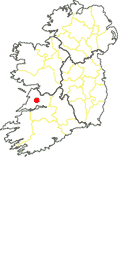
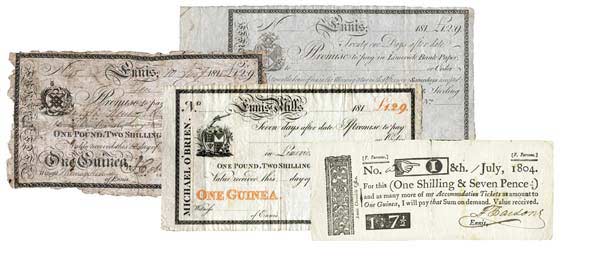
Ennis was home to several note issuers in the early 1800s. One of them at least operated as a bank, Francis McMahon, and was registered as such (1805-1816).
No notes of McMahon's bank are available for illustration. However, notes of other issuers have been recorded and are pictured here.
Some of the note issuers started to use a similar design for their notes around 1815. The name Ashby can be seen under the symbol on some of these notes, suggesting that they were printed by Ashby in London, the same printers who printed Maunsell's Bank of Limerick notes of the same era.
The designs of the notes differ in the symbol of the issuer and in the name printed along the left side in a sometimes barely legible uppercase script typeface.
Additionally, the payment details on the notes varied by issuer. All of the notes seen of this overall design were payable some days after presentation. The promissory statements on these notes indicate that they were payable to individuals in Limerick Bank Paper and transferable by endorsement.
Little is known of most of these issuers. They all appear to have been sole issuers. An action was taken against Peter Blake for bankruptcy in 1818 at the Royal Exchange, Dublin (Saunders' Newsletter [1]). It is not known if any of the other businesses failed or if their note issues were fully redeemed.
Peter Blake - Notes titled ‘Ennis Tan yard’ and later ‘Ennis’
John O’Donnell - Notes titled ‘Ennis’
Michael O’Brien - Notes titled ‘Ennis Mills’
Ennis Chronicle (Parsons) - Notes titled ‘Ennis Chronicle Office’
Francis McMahon, Ennis Bank - No notes seen
Information on Peter Blake here is based largely on his issued notes which bear dates in 1813 and 1815. Additionally, there is mention of his tan yard in the Irish Historic Towns Atlas, No. 25, p17, with a reference to the Ennis chronicle dated 20.1.1816, listing its location as unknown [2].
Peter Blake is most likely a businessman who issued notes as and when necessary without moving into banking, similar to other smaller 'bankers', such as Denis Moylan in Cork. Some of the note issuers who started as merchants did evolve into bankers, the most successful of these was La Touche in Dublin.
Saunders' Newsletter, Saturday 9 May 1818 contains a notice of an auction in the matter of 'Peter Blake, a bankrupt' at the Royal Exchange, Dublin on 13 May 1818 including land in Co. Clare.
Peter Blake issued notes as Ennis Tan Yard which were payable on demand: 'On Demand I will pay or order in Limerick Bank notes'.
His later note issues were of the Ashby design, though without the printer's name. These were payable some days after presentation, with a space left by the printers for the number of days to be entered manually. The two examples recorded were payable after 10 days.
There are two series of issued notes by design known for Peter Blake. Series 1 was issued under the heading 'Ennis Tan Yard', and Series 2 was of the Ashby design.
Denominations recorded: One Pound, One Guinea.
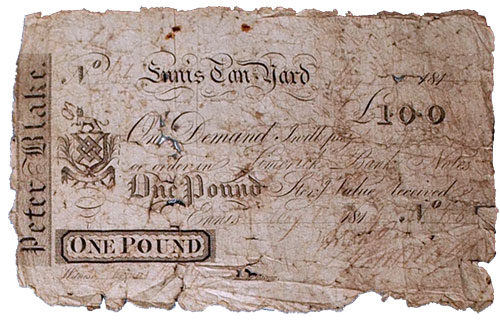
Ennis Tan Yard, Peter Blake, One Pound, 4 May 1813
[5. ex Whytes, 2001, Lot 314]

Ennis Bank, £1, 2 Shillings and 9 pence (1 Guinea), 10 January 1815, serial number 45
[4. ex Spink, 2008, Lot 781]
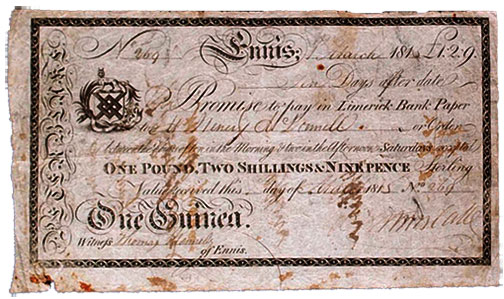
Ennis, Peter Blake, One Guinea, 1 March 1815, serial number 269
[5. ex Whytes, 2001, Lot 312]
Ennis Mills are located on the outskirts of the town, Mill Road E. The Irish Historic Towns Atlas, No. 25, p16 lists the mills as being in operation from 1656 up to around 1900 [2].
An observed note for One Guinea is the only reference to the note issue. Issued under 'Ennis Mills', the name Michael O'Brien is in serif uppercase to the left of the symbol. Michael O’Brien was presumably the owner of these mills at the time.
An interesting feature on the note is the early use of colour. Ashby is seen under the symbol. The promissory statement 'Seven days after date I promise to pay ............ or order in Limerick Bank Paper' suggests that this is a sight bill.
Denominations recorded: One Guinea unissued.
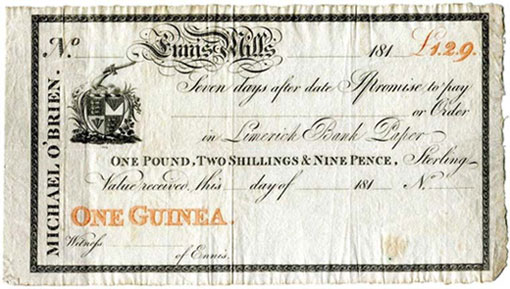
Michael O'Brien, Ennis Mills, One Guinea
O'Donnell appears to have never been registered as a banker, and was probably another merchant who started issuing notes. It is not known how long he was in business for, or what fate befell his business. However, there is a listing for an O'Donnell's Bank in the Irish Historic Towns Atlas, No. 25, p20, giving a reference to the Limerick Chronicle dated 17 Feb 1819, and an address at Harmony Row E, in Bull Hall House [2].
Issued under the title 'Ennis' a note for One Guinea with the name John O'Donnell along the side has been seen.
The note is payable 'Twenty one Days after date - Promise to pay in Limerick Bank Paper’ - this is almost certainlty a reference to Maunsell's Limerick Bank, one of the major banks in the region at the time.
This note is similar to that of Michael O'Brien in that the number of days after which it is payable is printed. In other respects, it is more similar to the 'Ennis' notes of Peter Blake in its details, and includes the statement of opening hours 'between the hours of ten in the morning and two in the afternoon, Saturdays excepted'.
Denominations recorded: One Guinea unissued.
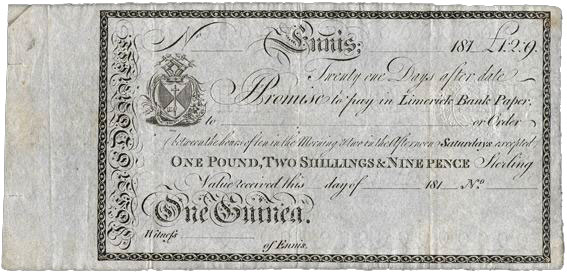
Ennis, One Guinea, John O'Donnell, ca1819
[6. ex Noonan's (DNW), 14 Mar 2009, Lot 453]
The Ennis Chronicle and Clare Advertiser was published on Monday and Thursday ca1784-1831 by Foster Parsons.
Examples of the newspaper from 1805 can be viewed on the Ennis Chronicle page of the Clare County Library website, where there is also some background information on the publication.
There are two series of issued notes by named persons: F Parsons, publisher of the paper, and Benjamin Parsons. The printing was crude by comparison with banker's notes of the day, and were likely printed in-house by the paper.
It is not known for how long the office of the Ennis Chronicle issued its currency notes.
The two notes which have been seen were issued for small amounts, and in two names: F. Parsons, and Benjamin Parsons. Considering that the newspaper was being produced over a long period of time, it is likely that its note issues were redeemed and paid up.
Denominations recorded: One shilling and seven pence halfpenny, Three shillings and nine pence halfpenny.
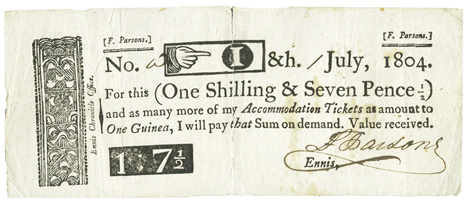
F. Parsons, Ennis Chronicle Office, One shilling and seven pence halfpenny, July 1804
This note is slightly unusual in that it is payable to the bearer on demand when the bearer has accumulated One Guinea's worth of the issuer's 'Accommodation Tickets'. Given that One guinea was equal to 22 shillings and 9 pence, a guinea amount was equal to 14 notes of this denomination.
[5. ex Whytes, 2001, Lot 311]
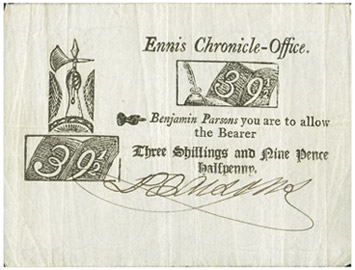
Benjamin Parsons, Ennis Chronicle Office, Three shillings and nine pence halfpenny, payable to bearer on demand
[5. ex Whytes, 2001, Lot 313]
Almost nothing is known of the business of Francis McMahon's bank. It is presumed that they issued notes.
There is a reference to the bank, address unknown, in the Irish Historic Towns Atlas, No. 25, p20, citing the Treble Almanac, pages 112 and 246, giving the years 1805 and 1816 [2]. According to Kenny and Turner (2019) [3], the bank was in business for several years (1805-1816), and it probably failed in the 1816 crisis.
References
1. Saunders' Newsletter, 9 May 1818.
2. Ó Dálaigh, B. (2012). 'Irish Historic Towns Atlas, No. 25, Ennis', Royal Irish Academy, Dublin. (Digital edition, www.ihta.ie, accessed 11 March 2021).
3. Kenny, S., Turner, J. D. (2019). 'Wildcat bankers or political failure? The Irish financial pantomime, 1797–1826', European Review of Economic History 24(4).
4. Auction Catalogue, Spink, London. Banknotes of the World, 19, 20 June, 2008.
5. Auction Catalogue, Whytes, Dublin. Coins, Banknotes, Medals & Militaria, 23 February, 2001.
6. Auction Catalogue, Noonan's (DNW), London. Important Collection of Irish Paper Money formed by Bob Blake (Part II), 14 March 2009.